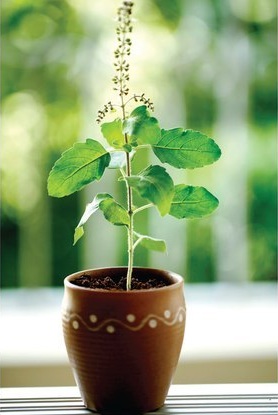 In addition to being grown for medicinal purposes, or as a focus of devotion, Tulsi wood is used for malas, or prayer beads. In the Skanda Purana, Hari Bhakti Vilasa states, “just by touching Her [Tulsi], one becomes pure.” By both chanting the names of God while touching the mala beads, one enters a transcendental mode of engaging both the mind and senses on God, becoming spiritually strong. –Vanessa Harris
In addition to being grown for medicinal purposes, or as a focus of devotion, Tulsi wood is used for malas, or prayer beads. In the Skanda Purana, Hari Bhakti Vilasa states, “just by touching Her [Tulsi], one becomes pure.” By both chanting the names of God while touching the mala beads, one enters a transcendental mode of engaging both the mind and senses on God, becoming spiritually strong. –Vanessa Harris
Tulsi is one of the most important herbs for yoga practitioners, along with anyone who wants a brighter and more sattvic mind, a stronger expansive heart, greater resilience to all forms of stress, and a sharper and more astute immune system. Tulsi, also known as holy basil, or Ocimum sanctum, is one of the most beloved herbs in Ayurveda; it is so beloved it is sometimes called the Queen of Herbs. Tulsi’s uses in Ayurveda are many and wide-ranging. It’s beneficial qualities include being good for the lungs, additionally, he plant is a tonic for the nervous system and an adaptogen that strengthens the adrenals.
Of course, it is convenient to run to the store for a bottle of Tulsi capsules or a box of Tulsi tea; may we always have this available to us on nearby shelves. However, just as the Yogic, Ayurvedic and Puranic traditions are adamant about our daily connection to Tulsi, tradition states that, optimally, it should be grown in our own homes. Our own gardens can be one of the most potent sources of medicine available to us. When cultivating herbs, growing plants rich in essential oils are important for health as these herbs contain powerful medicines and antioxidant compounds.
The following advice is based on my experience of growing Tulsi in India in my gardens and also from having been a player in growing thousands of tons of Tulsi in the North Indian fields of Western Oudh.[1]
Growing Tulsi
1) Growing Conditions: Tulsi loves to grow in rich loamy soil with ample precipitation and strong sun.
2) Soil: Where I have seen Tulsi grow the best with absolutely full power vitality is in fields of the North Central plains of India that are near rivers that occasionally overflow their banks. The land there is quite rich, though slightly sandy, and is fed using biodynamic techniques. Tulsi does fine in a standard rich potting soil.
3) Sun and Rain: Though Tulsi grows as a perennial throughout India, she loves to be planted right before the monsoon in the intense heat and sun of North Indian summers, and then in just 90-120 days, through the intense rains of the monsoon, she will grow to a height that will typically be at least two feet and often four or five feet. Years ago, in my garden in Lucknow, I had a volunteer Krishna Tulsi plant grow to eight feet tall and six feet across in just eighteen months.
4) First Planting (Seeds): In most areas, the first planting is in April, typically indoors in a greenhouse or some protected area. Emulate nature and plant your seeds in earthen pots, if possible, only about one-to-two cm deep, with a light covering of dirt.
5) Second Planting (Seedlings): Four to eight weeks after the initial planting, when the seedlings are 10-20 cm tall, transplant the Tulsi to larger pots for indoor growing, or outdoor to suitable beds or fields.
6) Variety: It is possible that until your Tulsi has grown, you will not know its variety; it is likely that it will be not be just a single variety but a hybrid.
7) Mantra: Traditionally mantras, songs, and other expressions of soul connection are both invoked by Tulsi Ma and appreciated by her.
Horizon Herbs (horizonherbs.com)
Richo Cech is one of the nation’s most experienced and favorite herbalists and the man behind Horizon Herbs, a source of herb seeds and seedlings. He has a YouTube video with Tulsi growing advice.
Cech advises that Tulsi may be grown in gardens across the Northern Hemisphere. The standard requirements are:
1) At least six hours of full sunlight daily.
2) Good quality organic potting or good garden soil.
3) Sowing seeds just barely beneath the surface, keeping warm, evenly moist, and in the light until germination. Tulsi takes much longer to germinate than standard garden basils. (Three weeks is average.)
4) Keep the plants weeded, and space one to two feet apart.
5) If fertilization is necessary, weed and cultivate with fingers around the plant, then dress the surface of the soil around the plant with one or two inches of organic compost, then water.
6) A positive attitude and prayers that the Tulsi will benefit all beings will help the plants along, and will bring blessings down on the gardener and all beings that come in contact with this holy herb. It is said that “even the ground beneath Tulsi is sacred”; we have found this to be true.
Yair Schers on Growing Tulsi
I am not sure if Yair loves Tulsi more than Tulsi loves Yair, but the love affair is a close match. He is, by far, the most skilled and powerful mala maker I know. Here are some of his tips:
“I have been growing Tulsi in Marin for 15 years, all from seeds I originally got from Seeds of Change. All seeds, soil and fertilizer are 100% organic. I grow Rama Tulsi, and though I started to also grow Krishna and Vana Tulsi two years ago, these instructions are for Rama Tulsi. Krishna and Vana Tulsi would be optimized with similar protocols.
1.) Best Soil: I have found that Organic Ocean Forest from FoxFarm is the best.
2.) Seedlings: I start the seeds in mid-May in clay pots where they will sprout and grow at rates depending on the weather that year.
3.) Watering: Water as needed so soil is wet then you can let it almost dry, but still slightly wet before watering again. Morning is the best time to water. I use either filtered water or let water sit in stainless or glass containers for 48 hours to off-gas chlorine and other contaminants. It is best to use spring or stream water. Do not use plastic for any water nor seedling container.
4.) Sun: Full sun is best, but Tulsi will grow in partial shade as long as there is six to seven hours of sun per day.
5.) Fertilizer: If using Fox Farm soil, there is no need to fertilize for the first four to six weeks. After that, I use seaweed and worm castings once a week till flowering. Once the Tulsi starts to flower, I add bat guano once a week. You can also make stinging nettle tea by bruising fresh leaves and soaking in water for ten days, stirring daily and then giving to it plants. You can also spray this tea on leaves as it is one of the best all-around plant foods I know of. By the way, it smells really strong.
6.) Pesticide: Tulsi is resistant to most bugs, but white fly and aphids can occasionally damage the plants, especially if the plant is not strong. If you have any problems with bugs, spray once a week with Neem oil, but never spray these sorts of things in the direct sun light.
7.) Seed Saving: I let the seeds fall in the pot and after plants die around November. Then I put the pot in a cool dry place for the winter (not easy in the Marin ‘winter’). In May, I take the pots outside under the sun and start watering them. Hundreds of seedlings sprout out from a single pot which I then can transfer. You can also wait until the seed pods are dry, then collect the seeds for future use. If growing directly in soil, the seeds will sprout around April or May.
 8.) Mantra: Tulsi loves to hear chanting, so chant away and enjoy the sacred energy and healing tea. One Mantra I use a lot is this:
8.) Mantra: Tulsi loves to hear chanting, so chant away and enjoy the sacred energy and healing tea. One Mantra I use a lot is this:
Om shri tulasyai vidmahe
vishnupriyayi dhimahi
tan no vrinda prachodayat.
9.) Imbibing the Tulsi Vibe: If you are growing Tulsi in pots, you can bring them inside the house at night for a wonderful experience. After all, having Tulsi within your house is one facet of what the tradition details.”
Jonathan Valdman on Growing Tulsi
Forever Flowering Greenhouses (foreverflowering.net )
“I have had the opportunity to grow Rama Tulsi at an 1800′ elevation in the Sierra Foothills of California. I have grown it under optimal greenhouse conditions in raised beds. It produced a ‘pampered’ product with an amazing, though scarce, essential oil that was distilled using both the leaves and flowers. I have also planted it under full sun in amended local earth. The plants grew smaller and were a little less fragrant, though the medicine was potent. The tea that was steeped from the leaves was fruity and refreshing and provided a feeling of strength and vitality. The outdoor plants went to seed and have provided me with volunteer Tulsi yearly since. We hope to be running some Tulsi in an aquaponics system this summer, so stay tuned.”
Santosh Hoehne on using herbs to strengthen Tulsi
SOS Organics (sosorganics.com)
Santosh, who has created the Himalayan-based herb company, SOS ORGANICS in Almora, is also one of my original partners/founders of Organic India. Santosh makes incredible Himalayan Nettle based fermentations of dozens of herbs and then sprays/pours that on his herbs.
“Use about 1 kg of fresh herbs for every 10 liters of water in a non-metal barrel and stir vigorously at least daily. When it stops fermenting, dilute it to 10% with water. I use the local spring water, and use it on my Tulsi and other plants. The plants love it and the whole ecosystem loves it.”
Traditional Fertilizers
As Tulsi is such an incredibly valuable and respected herb, there are many studies in India investigating how to optimize her growth. One such study[2] which sprayed onto Tulsi a combination of 2% Panchakavya + 0.2% Humic Acid + 2% Moringa Leaf Extract, 30 and 60 days after planting, resulted in much higher plant height, number of leaves, leaf area, leaf area index, and greater dried weight per square meter. Panchagavya, another incredible fertilizer that is part of the Vedic tradition, is a fermented concoction of a particular ratio of five products of cow: dung, urine, milk, curd, and ghee.
In Conclusion
I want to support us all to grow as many of our own herbs as possible. One might say, “Prashanti, because you are a key player within several herb companies, won’t people growing their own herbs hurt your business?” I am fundamentally a clinician and teacher, so anyone who knows me knows that other growers, herbalists, and herb companies are my allies in being a proponent of natural medicine and connection with Nature. It is the likes of the irresponsible greed-based facets of BigPharm, and any other force that keeps people disempowered and unenlightened that are the competition. If every person grew their own food and medicine I would be happiest of all.
Where to Find Tulsi Seeds
Collect seeds or cuttings from friends with a Tulsi plant.
Seed Sources:
Horizon Herbs: horizonherbs.com
Organic India: organicindia.com
The Living Seed Company: livingseedcompany.com
Contact Prashanti de Jager with questions about growing your own herbs: prashantidejagar.com.
[1] Oudh, also known as Avadh, is an ancient land with at least 10,000 years of incredible human history, for instance, it the kingdom of Rama, Sita and Lakshman. Organic India grows many of its herbs in Oudh. not far from Ayodhya.
[2] Prabhu, M.; Kumar, A. Ramesh; Rajamani, K.; Influence Of Different Organic Substances On Growth And Herb Yield Of Sacred Basil (Ocimum Sanctum L.); Indian Journal of Agricultural Research Volume: 44 Issue: 1 Pages: 48-52 Published: 2010
Based in Marin and in the Himalayas, Prashanti de Jager is a Vedic Science practitioner and teacher, a founder of Organic India, and author of several books on Vedic themes including The Truth Is, and Turmeric, the Ayurvedic Spice of Life. prashantidejager.com

